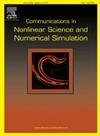Advantages of vibro-impact nonlinear energy sinks for vibration suppression of continuous systems: Coexistence of inter-modal energy scattering and targeted energy transfer
IF 3.8
2区 数学
Q1 MATHEMATICS, APPLIED
Communications in Nonlinear Science and Numerical Simulation
Pub Date : 2025-06-11
DOI:10.1016/j.cnsns.2025.108993
引用次数: 0
Abstract
Nonlinear energy sink (NES) is a lightweight nonlinear device that is attached to a primary system for passive energy localization into itself. In this paper, the energy transfer mechanism of the vibro-impact nonlinear energy sink (VI-NES) in continuous systems, and its consequences in vibration suppression is addressed. We uncovered the significance of a new distinctive energy transfer phenomenon termed inter-modal energy scattering (IMES), which was largely overlooked by most of the investigations concerning VI-NES. Considering a coupled system consists of a cantilever beam and an attached VI-NES, the non-smooth dynamics of the system is first formulated in a measure differential complementarity problem and treated using an energy-conserving integration method. Then the energy transfer mechanisms including the common targeted energy transfer (TET), the IMES, and their coexistence effect, are comprehensively investigated. Finally, the vibration damping performance of the VI-NES for the beam under harmonic force, broadband white noise, and transient shock excitations are also discussed and compared to other types of absorbers. It is demonstrated that the IMES is a distinctive phenomenon that can be realized only in the types of NESs with non-smooth vibro-impacts, to allow a broadband transfer of vibration energy among the eigenmodes of the host beam, resulting in hence a much more effective vibration reduction than the tuned mass damper (TMD) or other NESs.
振动冲击非线性能量汇抑制连续系统振动的优势:模态间能量散射与目标能量传递并存
非线性能量汇(NES)是一种轻量级的非线性装置,它附加在主系统上,用于将被动能量定位到系统本身。本文研究了连续系统中振动冲击非线性能量汇的能量传递机理及其在振动抑制中的作用。我们发现了一种新的独特的能量传递现象,称为模态间能量散射(IMES),这在很大程度上被大多数关于VI-NES的研究所忽视。考虑由悬臂梁和附加的VI-NES组成的耦合系统,首先将系统的非光滑动力学表述为测度微分互补问题,并采用节能积分方法进行处理。在此基础上,全面研究了共靶能转移(TET)、共靶能转移(IMES)及其共存效应。最后,还讨论了VI-NES在谐波力、宽带白噪声和瞬态冲击激励下对梁的减振性能,并与其他类型的吸振器进行了比较。研究表明,IMES是一种独特的现象,只能在具有非光滑振动冲击的NESs类型中实现,以允许主梁的本特征模态之间的宽带振动能量转移,从而导致比调谐质量阻尼器(TMD)或其他NESs更有效的减振。
本文章由计算机程序翻译,如有差异,请以英文原文为准。
求助全文
约1分钟内获得全文
求助全文
来源期刊

Communications in Nonlinear Science and Numerical Simulation
MATHEMATICS, APPLIED-MATHEMATICS, INTERDISCIPLINARY APPLICATIONS
CiteScore
6.80
自引率
7.70%
发文量
378
审稿时长
78 days
期刊介绍:
The journal publishes original research findings on experimental observation, mathematical modeling, theoretical analysis and numerical simulation, for more accurate description, better prediction or novel application, of nonlinear phenomena in science and engineering. It offers a venue for researchers to make rapid exchange of ideas and techniques in nonlinear science and complexity.
The submission of manuscripts with cross-disciplinary approaches in nonlinear science and complexity is particularly encouraged.
Topics of interest:
Nonlinear differential or delay equations, Lie group analysis and asymptotic methods, Discontinuous systems, Fractals, Fractional calculus and dynamics, Nonlinear effects in quantum mechanics, Nonlinear stochastic processes, Experimental nonlinear science, Time-series and signal analysis, Computational methods and simulations in nonlinear science and engineering, Control of dynamical systems, Synchronization, Lyapunov analysis, High-dimensional chaos and turbulence, Chaos in Hamiltonian systems, Integrable systems and solitons, Collective behavior in many-body systems, Biological physics and networks, Nonlinear mechanical systems, Complex systems and complexity.
No length limitation for contributions is set, but only concisely written manuscripts are published. Brief papers are published on the basis of Rapid Communications. Discussions of previously published papers are welcome.
 求助内容:
求助内容: 应助结果提醒方式:
应助结果提醒方式:


